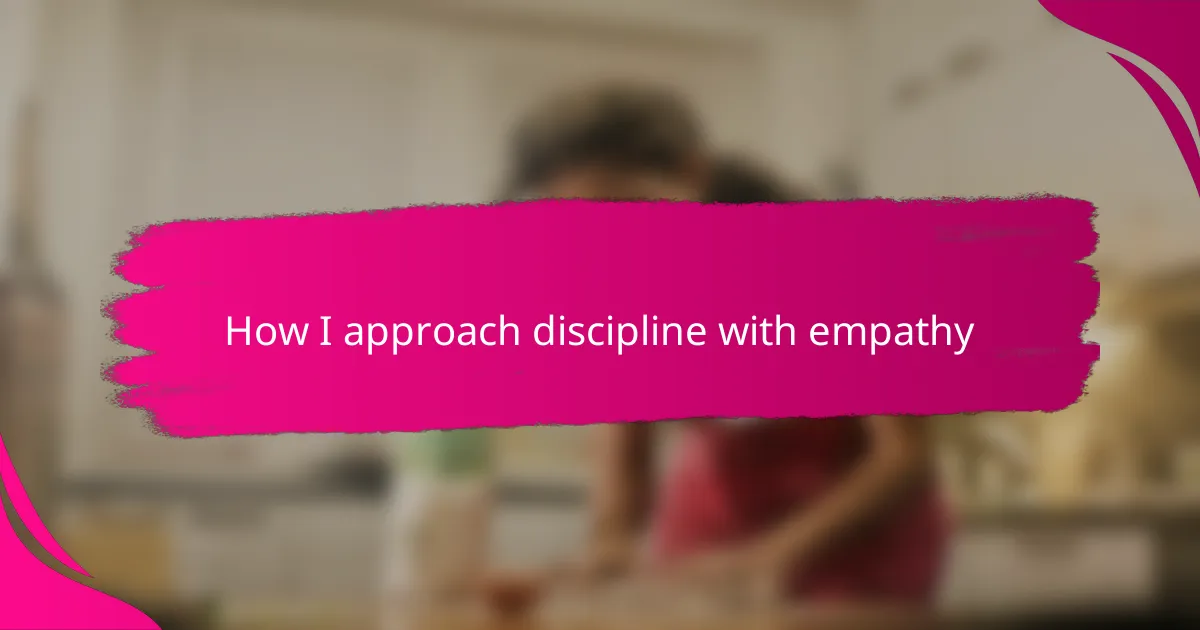Key takeaways
- Discipline should be approached with empathy, focusing on understanding the child’s emotions rather than just enforcing rules.
- Balancing empathy with clear boundaries fosters cooperation and trust, allowing children to feel secure while learning important lessons.
- Effective communication, such as engaging in dialogue and using eye contact, helps create a positive environment for interaction and discipline.
- Empathetic parenting transforms challenges into opportunities for connection and resilience, suggesting that emotional understanding is crucial for growth.
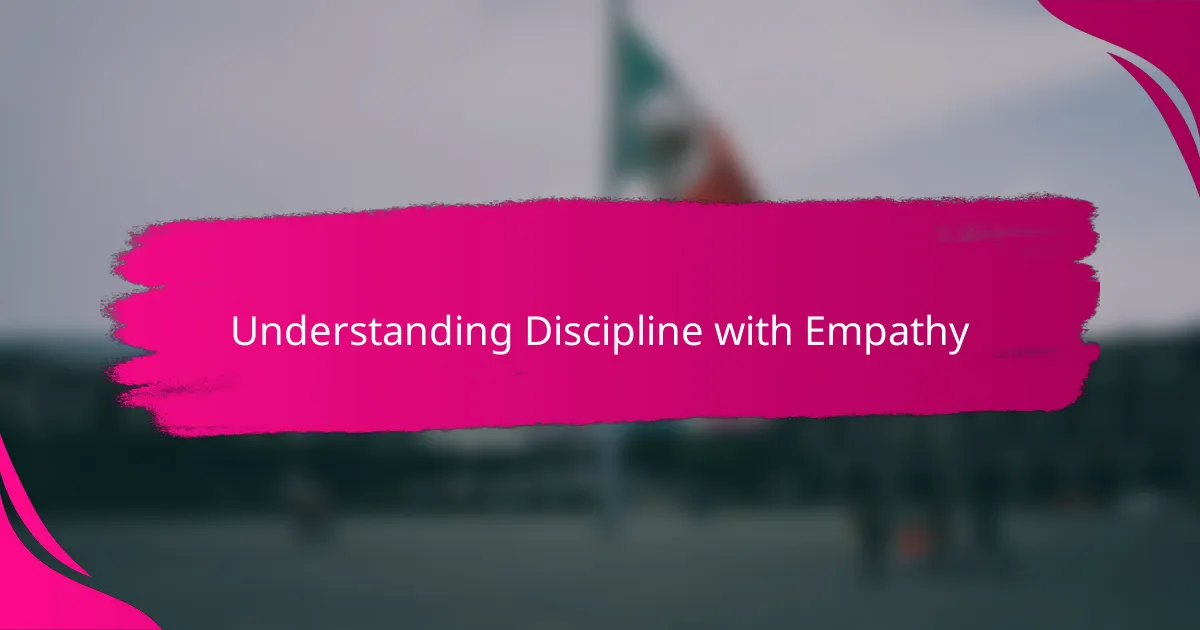
Understanding Discipline with Empathy
When I first started thinking about discipline, I realized it wasn’t just about rules or consequences. It’s about truly understanding where my child is coming from—what fears, frustrations, or needs lie beneath their behavior. Have you ever paused to wonder what your child might be feeling in that moment of misbehavior?
Empathy changes the game. Instead of reacting to the action, I try to listen with my heart, even when it’s hard. It reminds me of times when I’ve been misunderstood or judged too quickly, and how a little patience and kindness made all the difference.
Discipline with empathy doesn’t mean there are no boundaries; it means those boundaries come wrapped in respect and compassion. When I hold that space, I see my child not as the problem, but as someone learning and growing—just like me. Isn’t that what we all want?
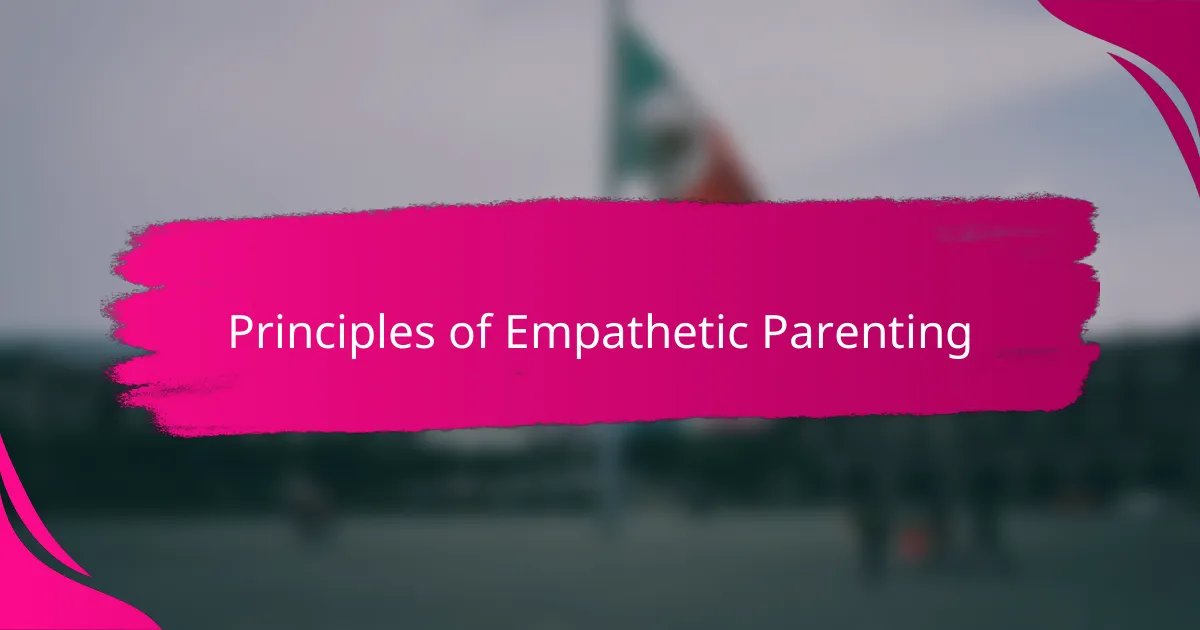
Principles of Empathetic Parenting
One principle I hold close is the commitment to truly listen before responding. When my child acts out, I remind myself to pause, rather than snap, and try to understand the emotions fueling their behavior. Have you noticed how much more cooperative kids can be when they feel genuinely heard?
Another key idea is balancing empathy with clear boundaries. I’ve learned that kindness doesn’t mean letting things slide; it means setting limits in a way that shows respect for my child’s feelings and growth. Reflecting on moments when I set firm but gentle boundaries, I saw my child respond with more trust and less resistance.
Lastly, I believe empathy requires patience—not just for my child but for myself too. Parenting is messy and imperfect, and sometimes I need to forgive my own mistakes as much as I want my child to learn from theirs. Have you ever caught yourself wishing for a second chance to handle a tough moment differently? I have, and that realization fuels my approach every day.
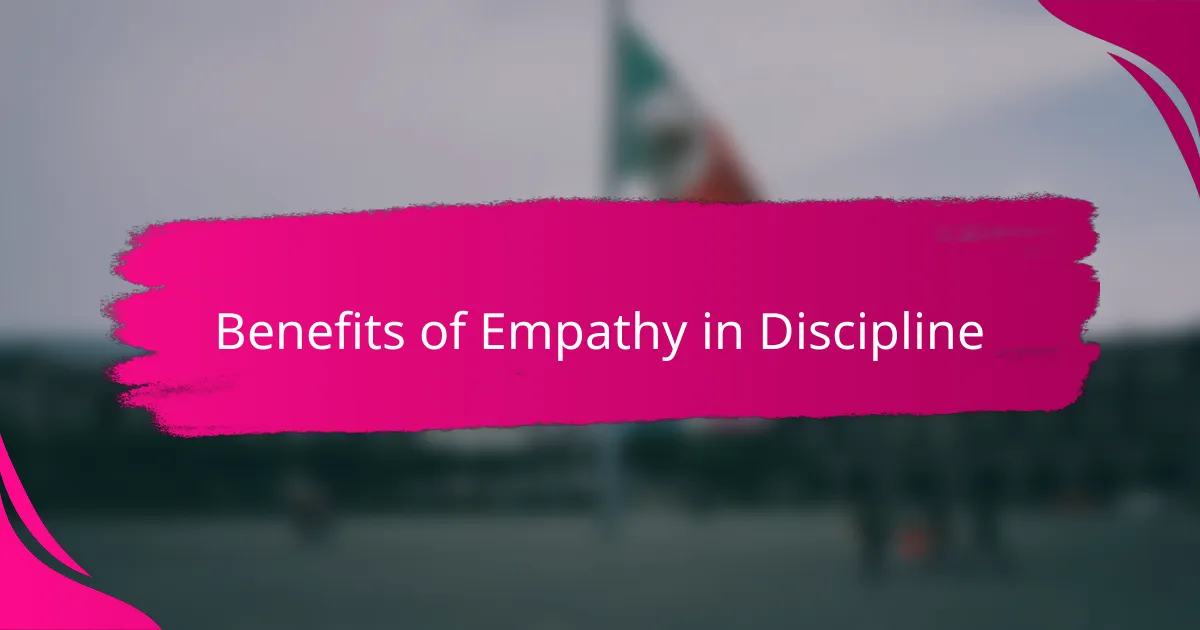
Benefits of Empathy in Discipline
When I started practicing empathy in discipline, I noticed a remarkable shift in my relationship with my child. Instead of power struggles, we began having conversations rooted in trust and understanding. Have you ever felt that breakthrough moment when your child opens up, not out of fear, but because they know you truly care?
Empathy also helps children develop emotional intelligence. By acknowledging their feelings during challenging moments, I’m teaching my child to recognize and manage emotions—skills that will benefit them for life. Isn’t it powerful to think that what feels like a tough discipline moment now is actually shaping their future resilience?
Another benefit I’ve experienced is that empathetic discipline reduces stress for both of us. When I approach behavior with compassion instead of anger, it calms the situation and makes problem-solving easier. It’s like changing the entire atmosphere in the room, turning conflict into connection—and who wouldn’t want that in their home?
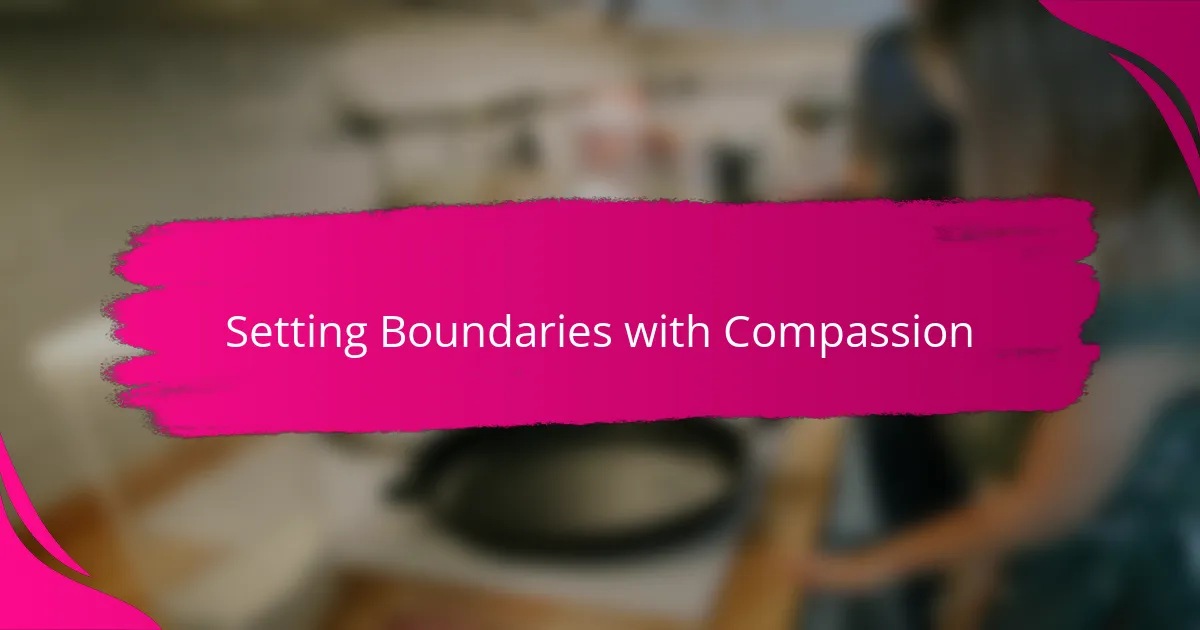
Setting Boundaries with Compassion
Setting boundaries with compassion has been a balancing act for me. I remember a time when my child was pushing limits, and instead of just saying “no,” I took a moment to explain why the boundary mattered. That simple act of sharing my reasoning seemed to soften the resistance and invite cooperation rather than defiance.
I’ve found that clear boundaries don’t have to feel like walls; they can feel like caring guidance. When I gently enforce rules, I try to speak with warmth and patience. Have you noticed how children respond differently when they sense that firmness comes from love, not frustration?
Sometimes, compassion in setting limits means acknowledging my child’s feelings even as I hold firm. Saying something like, “I see you’re upset, and I know this is hard, but this rule keeps you safe,” creates a bridge between empathy and discipline. In those moments, I feel we’re truly connected, not adversaries.
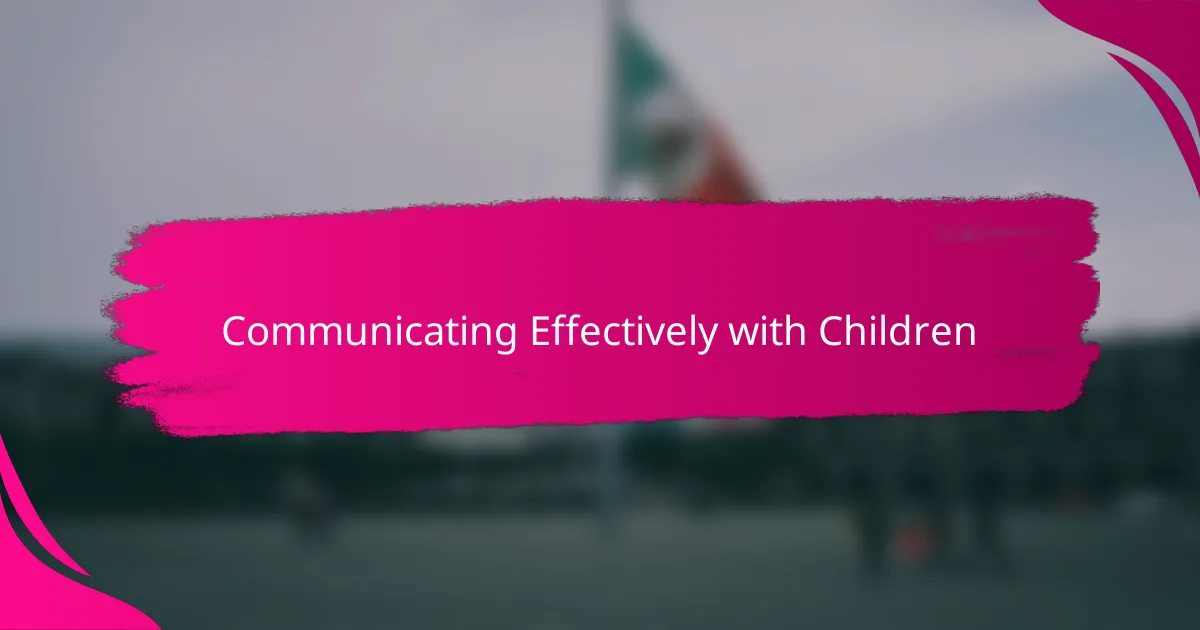
Communicating Effectively with Children
When I communicate with my child, I make a conscious effort to get down to their level—literally. Eye contact and gentle tone help me connect, showing I’m present and open. Have you ever noticed how simply kneeling down can shift the whole vibe of a conversation?
I also try to use words that invite dialogue rather than shut it down. Instead of saying, “Because I said so,” I ask, “What do you think about this?” It’s amazing how a simple question can encourage kids to think and share, turning discipline into a two-way street.
Sometimes, I admit, staying calm is the hardest part. But when I manage to keep my voice steady, I see my child mirror that calmness. It’s like a dance—my patience often leads theirs, and together we find understanding rather than frustration. Have you found your own rhythm in tough moments like these?
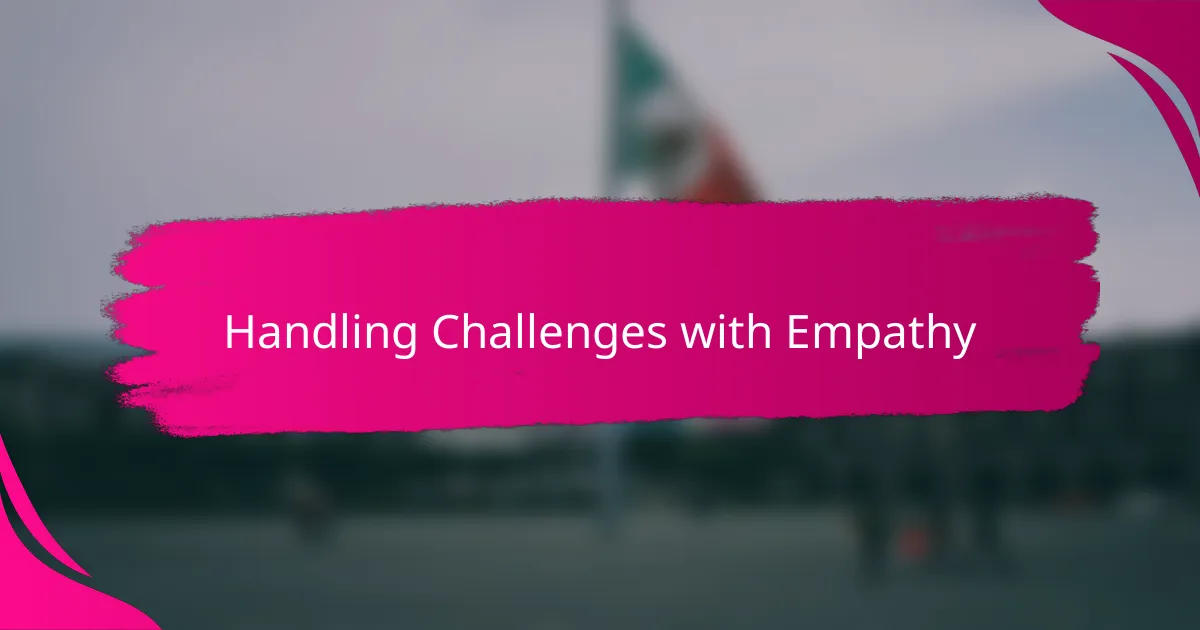
Handling Challenges with Empathy
Challenges in parenting can feel like stormy seas, but I’ve found that empathy acts like a steady anchor. When my child throws a tantrum or pushes a boundary, instead of reacting with frustration, I try to step into their shoes. Have you noticed how pausing to imagine their feelings can turn a meltdown into a moment of connection?
There was a time when my child was struggling with homework and lashed out in frustration. Instead of getting upset, I acknowledged their feelings and said, “I see this is really hard for you.” That simple recognition seemed to ease the tension and opened the door for us to work through the problem together. It taught me that empathy isn’t about fixing instantly—it’s about being present.
I also remind myself that challenges are chances to teach resilience, not just obedience. How often do we forget that children are learning to navigate their emotions, just like us? Embracing their struggles with compassion helps them feel safe to express themselves and grow stronger. Isn’t that the heart of empathetic discipline?

Personal Strategies for Empathetic Discipline
One strategy I rely on is pausing before addressing misbehavior. In those few seconds, I ask myself what emotion might be driving my child’s actions. I remember a time when my child suddenly slammed a door—I didn’t react immediately but quietly asked, “What’s going on?” That moment of pause opened up a conversation instead of a conflict.
Another approach I use is labeling feelings aloud to help my child feel seen. Saying things like, “I can tell you’re feeling frustrated right now,” has often softened tense moments. It’s surprising how much simply naming emotions can calm a situation and build trust between us.
Lastly, I make it a point to involve my child in problem-solving whenever possible. Instead of imposing a solution, I ask, “What do you think we could do differently next time?” This invites responsibility and shows respect for their perspective. Have you noticed how kids respond when they feel part of the solution rather than the problem? That shift has been powerful in my experience.
